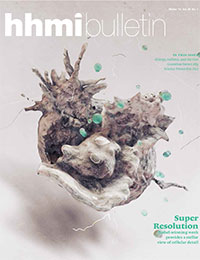Last month, Eric Betzig, a group leader at HHMI’s Janelia Research Campus, traveled to Sweden to accept the Nobel Prize in Chemistry. Eric shared the award with two other scientists, Stefan Hell, of the Max Planck Institute, and William Moerner, of Stanford University, for their remarkable contributions to push beyond the limits of light microscopy. It was a watershed moment for Eric and for all of us at HHMI. After all, Janelia was created with people like Eric in mind—scientists who are intellectually daring and committed to discovery, productivity, and perseverance.
Eric joined HHMI in October 2005, a year before the doors opened at Janelia. He shared the Institute’s vision for the campus: a place where small, interdisciplinary groups work collaboratively to build powerful tools and pursue some of science’s most profound questions. And he helped recruit other talented scientists, including his close friend and PALM microscope collaborator Harald Hess.
As they and other Janelians built their labs in those early days, they were also helping to establish the principles and culture that now characterize this unique community. From the outset, sharing Janelia’s resources and tools with the broader scientific community was part of our plan. One example of that is our visiting scientist program. We also recently partnered with the Gordon and Betty Moore Foundation to establish an Advanced Imaging Center, where select scientists from around the world can access potentially transformative imaging tools developed at Janelia, including those developed by Eric.
From the outset, sharing Janelia’s resources and tools with the broader scientific community was part of our plan.
Robert Tjian
My own work has benefited greatly from super-resolution imaging systems like PALM and Eric’s more recent lattice light sheet microscope, which captures three-dimensional images of living cells with exceptional clarity and detail. These tools have allowed my team to track the movement and binding activity of individual transcription factors, which help transcribe DNA into RNA, in living human or animal cells. We can determine how long a protein needs to find a target site, how much time it spends at that site, and in what order the multiple proteins that make up the transcription machine complex are assembled.
My lab has long hoped to “watch” transcription factors in action in normal and diseased cells. We are still early on in this exciting journey, but we know that single-molecule, single-cell imaging will significantly impact studies of transcription mechanisms, which will in turn help us understand how genes are expressed during an organism’s development and how disease disrupts this process.
It’s worth noting that the 2006 publication on PALM was the first journal article to come out of Janelia. Today, as Janelia approaches its 10th anniversary, the campus includes some 800 people, including scientists in fields ranging from computation to engineering to neural theory. We have much work to do—and more discoveries ahead.










